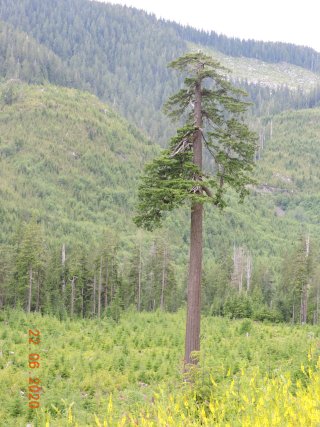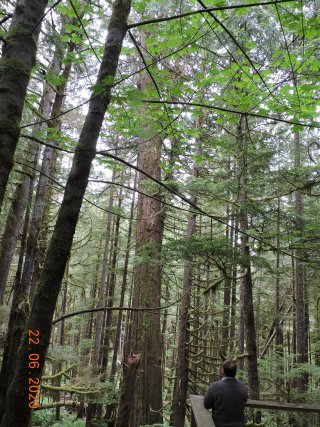North in the Spring #13
Big Lonely Doug by John Neville We travelled west from Victoria on Highway 14 on the Pacific Marine Circle Route towards Port Renfrew, "the Tall Tree Capital of Canada". The first stop was at Whiffin Spit, a km long gravel spit which reaches across Sooke Bay to form Sooke Harbour. On the ocean side pacific rollers came crashing in. Black Turnstones were flirting with the waves as they foraged for food amongst the rocks.  The road continues, sometimes right along the littoral, it seemed like the edge of the world. Our nostrils were full with the dank, salty smell of the ocean. Our next stop was Sandcut Beach, at Jordan River Regional Park. It was a good climb down to the beach! The trail led us between large fir trees, tangled roots, Salal and Sword Ferns. We counted three Swainson's Thrush, a pair of Pacific Wren, one Wilson's Warbler and a Veery. We enjoyed the serenading but in reality, they came close to check us out. The Strait of Juan de Fuca was openning up toward the Pacific. Across the strait the western slopes of the Olympic mountains were quite clear. We were close to the mouth of the Jordan River, known as Diitiida by the First Nations, which means drifted ashore. The Pacheedaht (People of the Seafoam) and the Ditidaht lived together here, before the Great Flood in 1700.
The road continues, sometimes right along the littoral, it seemed like the edge of the world. Our nostrils were full with the dank, salty smell of the ocean. Our next stop was Sandcut Beach, at Jordan River Regional Park. It was a good climb down to the beach! The trail led us between large fir trees, tangled roots, Salal and Sword Ferns. We counted three Swainson's Thrush, a pair of Pacific Wren, one Wilson's Warbler and a Veery. We enjoyed the serenading but in reality, they came close to check us out. The Strait of Juan de Fuca was openning up toward the Pacific. Across the strait the western slopes of the Olympic mountains were quite clear. We were close to the mouth of the Jordan River, known as Diitiida by the First Nations, which means drifted ashore. The Pacheedaht (People of the Seafoam) and the Ditidaht lived together here, before the Great Flood in 1700.
After crossing the San Juan River near Port Renfrew we proceeded on Gordon River Main Road to Avatar Grove. It is a wonderful area of old growth trees including massive Western Red Cedar with large burls and very tall Douglas-Firs. You can feel a stillness by the trees, like the calm next to pillars in a cathedral. There is also a natural spiritual wonder about the place. Not only am I stepping between monarchs of the living world, but below each footstep, experts tell me that there are at least 18.000 invertebrates at work. The tiny critters break down detritis from the canopy, old logs, fish carcasses and waste from birds and animals. In old forests there are also the Mycorrhizal Fungi connections which join myriad tree roots in symbiotic pathways. Sugars are photosynthesized from carbon dioxide in the canopy and transferred via the roots and fungi to other plants throughout the forest. The fungi absorb phosphorous, nitrogen and other nutrients and share them with the tall trees.  It was easy to recognize that: Varied Thrush, Pacific Wren, Roughed Grouse, Swainson's Thrush, Townsend Warbler, Wilson's Warbler all were proclaiming the living forest. Avatar Grove is indeed one of the grandest ancient forests still in existence in southern Vancouver Island, and reasonably accessible in a high clearance vehicle. We were on Pacheedaht First Nations unseeded lands, which has sustained the people since time immemorial.
It was easy to recognize that: Varied Thrush, Pacific Wren, Roughed Grouse, Swainson's Thrush, Townsend Warbler, Wilson's Warbler all were proclaiming the living forest. Avatar Grove is indeed one of the grandest ancient forests still in existence in southern Vancouver Island, and reasonably accessible in a high clearance vehicle. We were on Pacheedaht First Nations unseeded lands, which has sustained the people since time immemorial.
After crossing a canyon, maybe 70 m. deep, we reached Big Lonely Doug. We stood on a logging road above Big Doug, so it was a little difficult to fully appreciate his true height. Some of the trees and bushes around him are maybe 5 m. tall in the clearcut in the valley bottom. Its shape illustrates that it was once part of an old growth forest, only contributing to the canopy at the very top. A climber reported that: in the crown, epiphytes included ferns, huckleberry and honeysuckle bushes growing off moss covered branches. I could hear a woodpecker excavating on a snag and the referee-like calls of a Varied Thrush, but no other birds sang like in Avatar Grove. It had been calm and sheltered in the old growth forest, but the wind was blowing steadily across the clearcut.  Big Lonely Doug is the second biggest Douglas-Fir known in the world! It's estimated to be 1000 years old. It has been precisely measured at 66 m. tall. The base diameter is just under 4 m. The biggest Douglas-Fir in the world is the Red Creek Fir, 73.8 m. tall and 4.2 m. in diameter. It's only an hour away, down several twisty turns of logging road. The tallest Sitka Spruce at more than 95 m. and is located in the Carmanah Walbran Provincial Park. Access to this tree is limited to a 2 km side trail, off the West Coast Trail. The Cheewhat Western Red Cedar is the largest tree by volume and located off the road to Bamfield. This is a giant of giants. Another great place to see big Western Red Cedar is at Cathedral Grove on Hwy 4.
Big Lonely Doug is the second biggest Douglas-Fir known in the world! It's estimated to be 1000 years old. It has been precisely measured at 66 m. tall. The base diameter is just under 4 m. The biggest Douglas-Fir in the world is the Red Creek Fir, 73.8 m. tall and 4.2 m. in diameter. It's only an hour away, down several twisty turns of logging road. The tallest Sitka Spruce at more than 95 m. and is located in the Carmanah Walbran Provincial Park. Access to this tree is limited to a 2 km side trail, off the West Coast Trail. The Cheewhat Western Red Cedar is the largest tree by volume and located off the road to Bamfield. This is a giant of giants. Another great place to see big Western Red Cedar is at Cathedral Grove on Hwy 4.
The internet gives details on how to get to these magnificent trees. The book "Big Lonely Doug: The Story of One of Canada's Last Great Trees" by Harley Rustad, gives you a wonderful history of the trees and much more. |